- Last Updated: December 16th, 2025
Key Takeaways
PCBs are environmental toxins with far-reaching impacts on ecosystems.
Persistent global efforts aim to monitor and mitigate PCB contamination.
International cooperation is pivotal in combating the public health risks associated with PCBs.
Overview of PCB Contamination
On this page, we’ll discuss a global perspective on PCB contamination, the environmental impact of PCB contamination, health risks associated with exposure to PCBs, and much more.
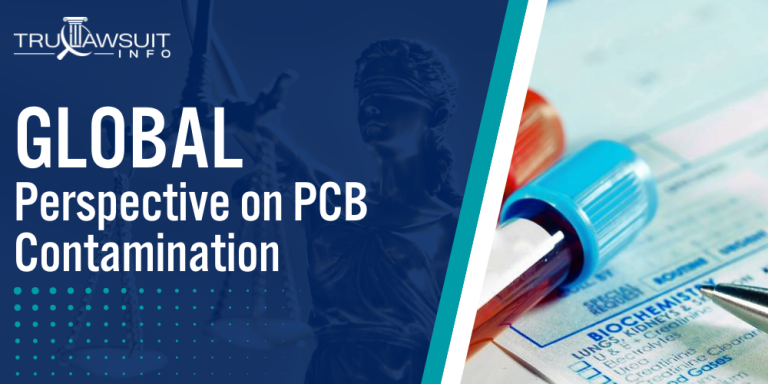
Intro To PCB Contamination
The persistent nature of PCBs has led to their accumulation in the environment.
Here are some key aspects of the global PCB contamination problem:
- Geographic Distribution: PCB contamination is found in nearly every corner of the globe, from the Arctic to the Antarctic.
- Bioaccumulation: PCBs accumulate in the fatty tissues of living organisms, magnifying as they move up the food chain.
- Health Effects: Exposure to PCBs has been linked to various health issues, including cancer, immune system damage, and reproductive disorders.
- Remediation Challenges: The cost and complexity of cleaning up PCB-contaminated sites pose significant challenges for countries worldwide.
If you or a loved one has experienced adverse health conditions after being exposed to PCB chemicals, you may qualify to pursue compensation.
Contact TruLawsuit Info using the chat on this page to receive an instant case evaluation to determine if you qualify to file a PCB lawsuit today.
Global Perspective on PCB Contamination Issues
Polychlorinated biphenyls (PCBs) remain a persistent environmental concern, as their legacy and present-day impacts are felt globally.
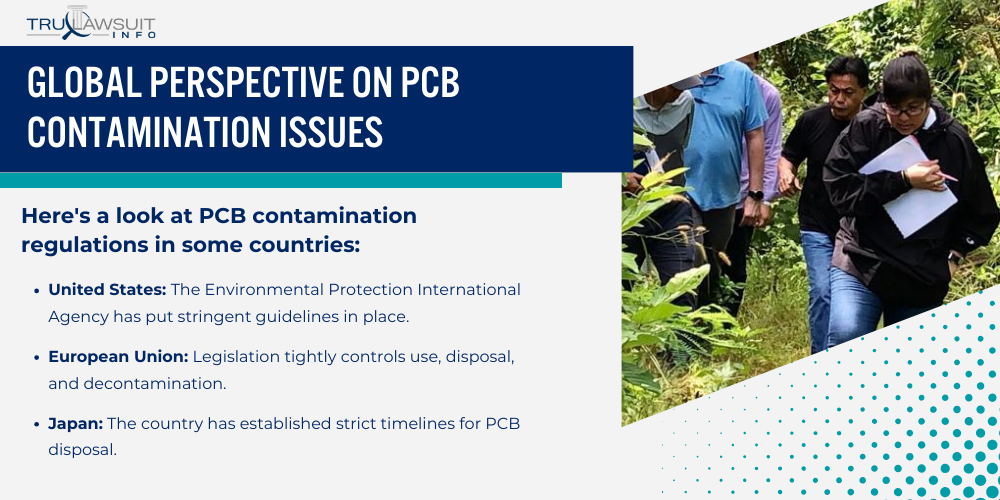
This section delves into the intricacies of international regulations, the extent of PCB pollution, and collaborative efforts to address this pervasive issue.
PCB Contamination Regulations Across Different Countries
Regulatory measures for PCBs vary significantly across countries.
Here’s a look at PCB contamination regulations in some countries:
- United States: The Environmental Protection International Agency has put stringent guidelines in place.
- European Union: Legislation tightly controls use, disposal, and decontamination.
- Japan: The country has established strict timelines for PCB disposal.
- Canada: Governed by a comprehensive framework aligning with international standards.
The disparities in regulations reflect the urgency and resources each country dedicates to managing PCB pollution.
Analyzing the Scope of Global PCB Contamination
Understanding the magnitude of PCB contamination aids in grasping its seriousness.
Evidence from various sources reveals the widespread presence of PCBs:
- Sampling studies indicate widespread pollution in marine ecosystems.
- Industrial sites, especially in developing nations, show elevated PCB levels.
- PCBs in wildlife suggest global diffusion, even in remote areas.
- Long-range atmospheric transport plays a role in dispersing airborne PCBs.
Extensive research further underscores the need for a coordinated global response.
Strategies for International Cooperation in PCB Contamination
Collaborative efforts are crucial for effectively tackling PCB pollution.
Here are some examples of international cooperation strategies to address PCB contamination:
- Global technology transfer initiatives encourage the sharing of best remediation practices.
- International agencies emphasize policy harmonization.
- Capacity building in developing nations is a focus of several international agreements.
- Frameworks for global governance, such as the Stockholm Convention, facilitate joint action.
By fostering international cooperation, countries can enhance their response effectiveness to control and mitigate PCB pollution.
PCB Contamination Monitoring and Environmental Impact
Polychlorinated biphenyls (PCBs) are a potent source of environmental contamination, affecting ecological and environmental health.
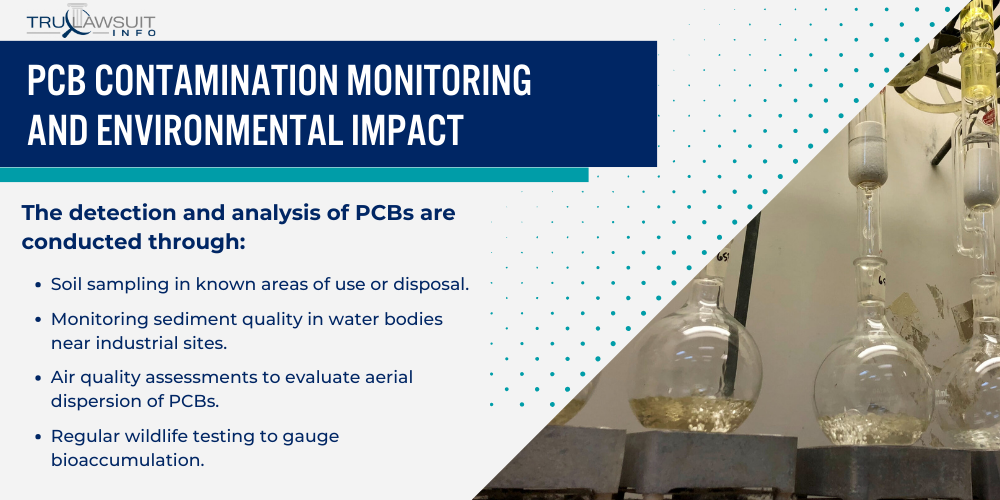
This section explores the systematic approach to monitoring polychlorinated biphenyl (PCB) prevalence and its impacts on ecosystems.
Global Environmental Monitoring for PCB Contamination
Global efforts are underway to monitor PCB levels in various environments, from contaminated soil and PCB oil to aquatic ecosystems.
PCBs leach from soil slowly, particularly the more highly chlorinated congeners, and translocate to plants via soil insignificantly.
The detection and analysis of PCBs are conducted through:
- Soil sampling in known areas of use or disposal.
- Monitoring sediment quality in water bodies near industrial sites.
- Air quality assessments to evaluate aerial dispersion of PCBs.
- Regular wildlife testing to gauge bioaccumulation.
Assessing the Ecological Effects of PCB Contamination
PCBs threaten wildlife, from the smallest organisms to top predators.
Current assessments focus on:
- Tracking changes in reproductive health of exposed species.
- Studying bioaccumulation in food chains.
- Evaluating the degradation of ecosystem functions.
- Analyzing changes in biodiversity around contaminated sites.
Long-Term Environmental Studies on PCB Contamination
Long-term studies are imperative to understand PCBs’ persistence and chronic effects on the environment.
These studies focus on:
- The transformation of PCBs in different environmental media.
- The recovery of ecosystems post-remediation efforts.
- Continuous monitoring of contaminated sediment and soil.
- Health tracking of exposed human and wildlife populations over time.
International Treaties and Agreements on PCB Contamination
In response to PCB contamination, several international treaties have been established to mitigate these persistent organic pollutants’ environmental and health impacts.
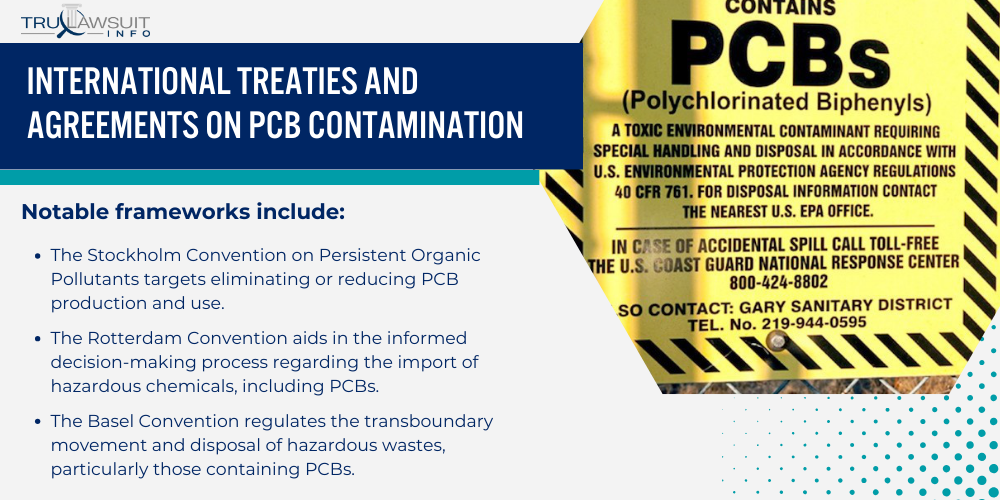
Frameworks for Global Governance of PCB Contamination
International governance of PCB contamination has been structured to prevent and control the release of these harmful chemicals into the environment.
Notable frameworks include:
- The Stockholm Convention on Persistent Organic Pollutants targets eliminating or reducing PCB production and use.
- The Rotterdam Convention aids in the informed decision-making process regarding the import of hazardous chemicals, including PCBs.
- The Basel Convention regulates the transboundary movement and disposal of hazardous wastes, particularly those containing PCBs.
- Regional agreements such as the Aarhus Protocol on Persistent Organic Pollutants under the UNECE Convention on Long-range Transboundary Air Pollution.
Ratification and Implementation of PCB Contamination Treaties
The effectiveness of treaties on PCB contamination hinges on their ratification and implementation by signatory countries.
Key points include:
- As of the date of this article, most nations have ratified these treaties, thereby committing to national action plans to reduce PCB concentrations.
- Implementation varies depending on the country’s capacity to replace and safely dispose of PCB-containing equipment.
- International cooperation and partnerships often provide technical and financial support for implementation.
- Regular reporting and data sharing among signatories are vital for assessing progress and ensuring compliance.
International Agreements Reducing PCB Contamination
Several agreements have been proactive in reducing PCB contamination globally.
Highlights of their impact include:
- Adopting best practices for the management and disposal of PCBs aligns with environmentally sound management principles.
- Encouragement of alternative technologies to replace PCBs in new equipment.
- Reduction in the global stockpile of PCBs through controlled disposal methods and cleanup of contaminated sites.
- Efforts to monitor and evaluate PCB levels in the environment, including the air and food chain, to assess the effectiveness of the implemented measures.
Global Public Health Initiatives Against PCB Contamination
Public Health Initiatives have become fundamental in combating the pervasive issue of PCB contamination.
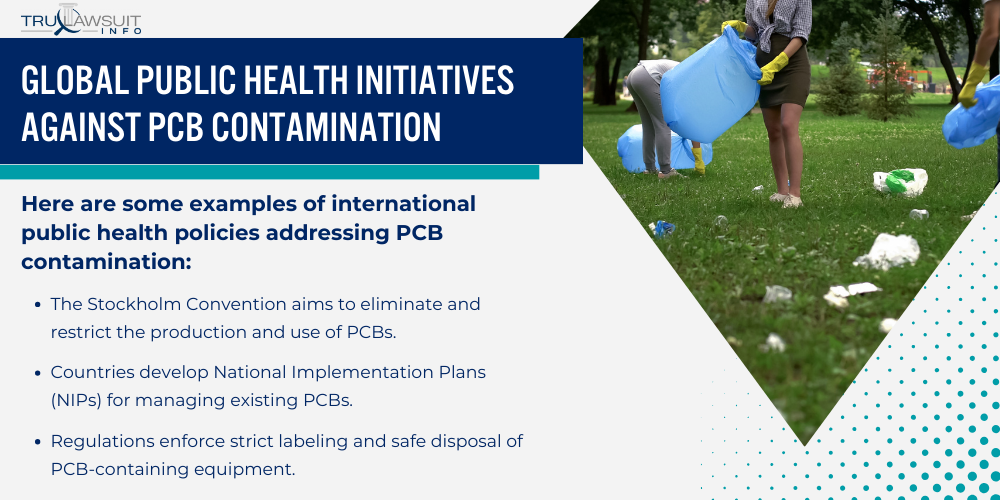
These measures are pivotal for safeguarding human health and guiding public health policies.
Public Health Policies Addressing PCB Contamination Worldwide
Policies at the international level significantly influence how nations address the risks posed by PCBs to public health.
They provide a regulatory backbone for local governments.
Here are some examples of international public health policies addressing PCB contamination:
- The Stockholm Convention aims to eliminate and restrict the production and use of PCBs.
- Countries develop National Implementation Plans (NIPs) for managing existing PCBs.
- Regulations enforce strict labeling and safe disposal of PCB-containing equipment.
- The World Health Organization (WHO) classified PCBs as carcinogenic, prompting legislative measures to control exposure.
Collaborative Health Programs Tackling PCB Contamination
Collective efforts are critical to address the borderless issue of PCB contamination.
Several collaborative programs are working to address PCB contamination:
- The Global Environment Fund (GEF) supports developing countries in PCB management.
- Programs such as those by the United Nations Environment Programme (UNEP) focus on the safe disposal of PCBs.
- Multinational projects work toward raising awareness of PCB-related health effects.
- Partnerships across sectors help establish best practices for reducing exposure.
PCB Contamination and Its Impact on Global Health Indices
Health indices globally reflect the consequences of PCB contamination.
Here are some of the key ways PCB contamination impacts global health indices:
- Persistent PCB presence is linked to adverse health effects like cancer and immunological disorders.
- Studies correlate high exposure areas with increased rates of health problems.
- Efforts to track and reduce PCBs are incorporated into broader environmental health indicators.
- Assessing public health impact contributes to shaping policies and remediation strategies.
Through steadfast policies and collaborations, progress has been made in eradicating the threat of PCBs to public health, though challenges remain.
Economic Implications of PCB Contamination Worldwide
Chlorinated hydrocarbons have wide-ranging economic implications due to their persistence in the environment and potential to spread across various media.
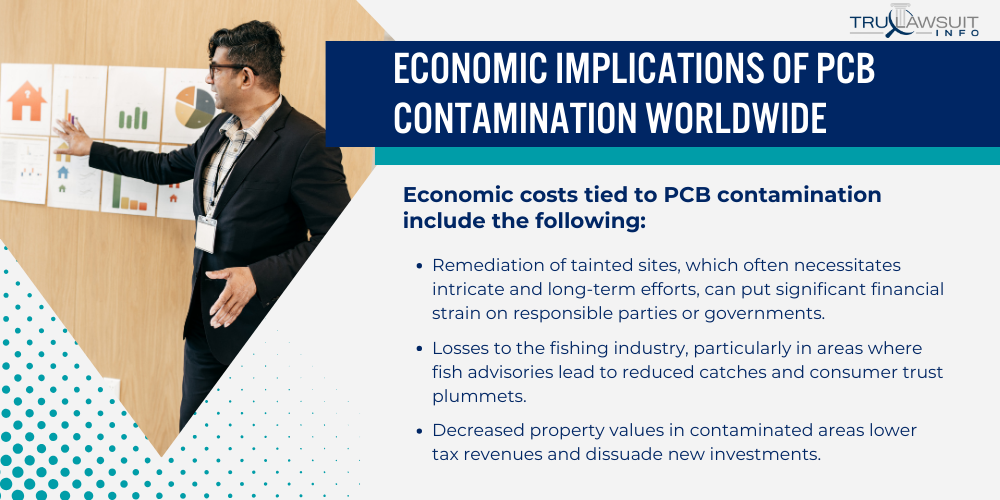
This section examines the direct economic costs associated with PCB contamination, investments in financial aid for remediation, and the influence of economic policies in mitigating these impacts.
Evaluating the Economic Costs of PCB Contamination Globally
The pervasive nature of PCBs can have a profound impact on economies worldwide.
Economic costs tied to PCB contamination include the following:
- Remediation of tainted sites, which often necessitates intricate and long-term efforts, can put significant financial strain on responsible parties or governments.
- Losses to the fishing industry, particularly in areas where fish advisories lead to reduced catches and consumer trust plummets.
- Decreased property values in contaminated areas lower tax revenues and dissuade new investments.
- Public health expenditures escalate due to increased healthcare costs linked to exposure-related conditions, including efforts to monitor and mitigate adverse health effects on affected populations.
Financial Aid and Investments for PCB Contamination Mitigation
Funding and financial aid play a pivotal role in addressing the aftermath of PCB contamination.
The assistance typically targets the following areas:
- Research grants to develop more cost-effective and efficient remediation technologies.
- Financial support is needed for local communities to clean up and restore ecosystems impacted by the PCBs contamination.
- Investing in public health initiatives to monitor and prevent potential human exposure.
- International aid programs to assist countries with limited resources in managing and mitigating PCB contamination.
The Role of Economic Policy in Addressing PCB Contamination
Economic policies are key in forging a path towards mitigating PCB contamination.
These policies shape how societies approach the problem from a financial perspective:
- Implementing taxes or fines on entities responsible for PCB releases can incentivize prevention and fund cleanup efforts.
- Subsidies or tax incentives for businesses that adopt practices to reduce or eliminate PCB pollution.
- Policy frameworks to support international cooperation, sharing remediation technologies, and financial resources to address transboundary contamination.
- Regulatory measures that govern the import, export, and disposal of materials containing PCBs to prevent further environmental and economic damage.
Technological Advancements in PCB Contamination Management
The management of PCB contamination has seen significant progress, thanks to new technologies that improve detection and remediation methods.
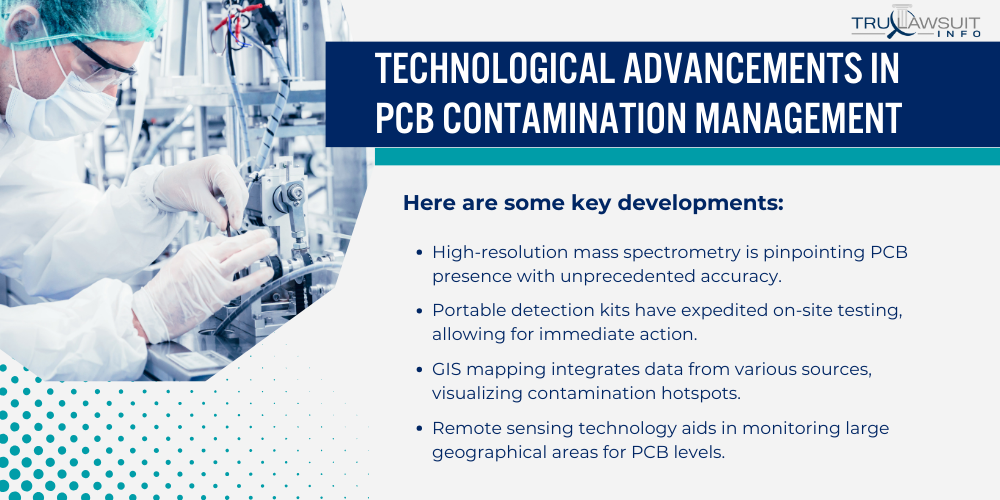
These innovations are leading the way toward a cleaner and safer environment.
Innovations in Detecting and Managing PCB Contamination
Recent technological breakthroughs have enhanced the capability to identify and manage PCB contamination.
Here are some key developments:
- High-resolution mass spectrometry is pinpointing PCB presence with unprecedented accuracy.
- Portable detection kits have expedited on-site testing, allowing for immediate action.
- GIS mapping integrates data from various sources, visualizing contamination hotspots.
- Remote sensing technology aids in monitoring large geographical areas for PCB levels.
These methods have streamlined the process, making it more efficient to respond to contamination occurrences.
Global Technology Transfer for PCB Contamination Cleanup
There is a growing movement to share cutting-edge techniques for PCB cleanup globally.
Vital strides include:
- Collaborative platforms enable countries to share best practices and technological know-how.
- The adoption of international protocols ensures a standardized approach in addressing PCB dangers.
- Agencies are nurturing partnerships for research and development, pooling resources for better outcomes.
- Initiatives are focusing on capacity building in developing nations to handle PCB-related challenges.
Such cooperation fosters an inclusive approach to tackling the pervasive issue of PCB pollution.
Advancements in Bioremediation for PCB Contamination
Bioremediation techniques harness nature’s mechanisms to degrade PCB compounds safely.
Here are some notable advancements:
- Genetically engineered microorganisms are being developed to break down PCBs more effectively.
- Studies into plant-based phytoremediation have discovered species that can absorb PCBs from the soil.
- Techniques focusing on enhancing native microbial populations show promise for in-situ remediation.
- Innovative bioaugmentation strategies are being trialed to introduce potent PCB-degrading bacteria into affected environments.
These bioremediation approaches are key to reducing the environmental impact of PCBs without introducing further toxins.
Educational and Awareness Programs on PCB Contamination
Effective educational and awareness programs are fundamental in addressing the challenges posed by PCB contamination.
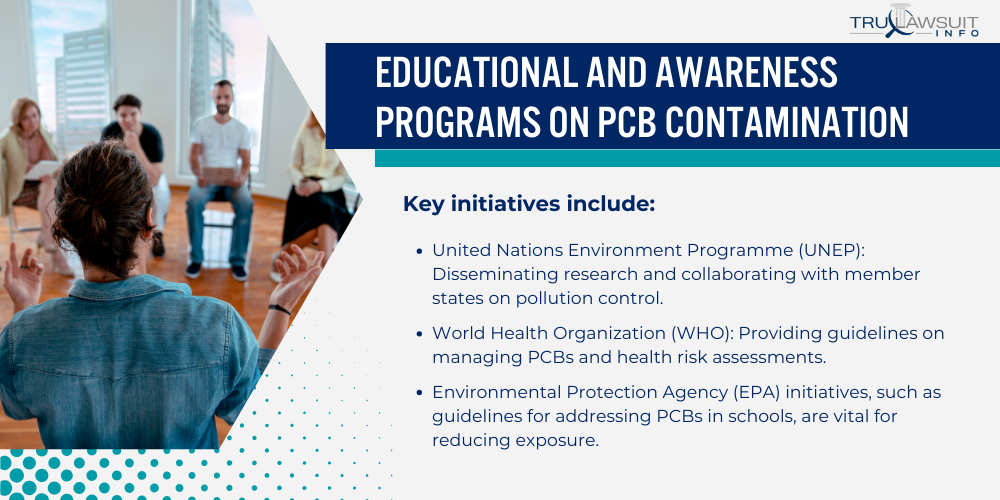
These programs aim to inform the public about the risks and encourage collective action toward minimizing exposure.
International Campaigns to Raise Awareness of PCB Contamination
International efforts to heighten awareness of PCB risks involve various stakeholders, including governments, NGOs, and intergovernmental organizations.
They often employ a mix of media, conferences, and informational materials to reach a broad audience.
Key initiatives include:
- United Nations Environment Programme (UNEP): Disseminating research and collaborating with member states on pollution control.
- World Health Organization (WHO): Providing guidelines on managing PCBs and health risk assessments.
- Environmental Protection Agency (EPA) initiatives, such as guidelines for addressing PCBs in schools, are vital for reducing exposure.
- Awareness campaigns that prioritize health education and provide resources for safe PCB disposal.
Education as a Tool for Preventing PCB Contamination
Education plays a critical role in PCB contamination prevention by equipping individuals with the knowledge to make informed decisions.
Educational strategies include:
- Integrating PCB-related topics into school curricula to lay a foundation of awareness from an early age.
- Conducting community workshops that offer practical advice on reducing exposure.
- Developing online courses and modules that make learning about PCBs accessible to a wider audience.
- Partnering with local industries to train employees on safe handling and disposal practices.
Building a Global Discourse on PCB Contamination Prevention
To build a global conversation around PCB prevention, stakeholders must continuously dialogue to share best practices and innovative solutions.
Efforts to foster this dialogue include:
- International conferences that bring together experts to share research findings and policy recommendations.
- Collaborative online platforms where ideas and strategies can be exchanged.
- Publications from authoritative sources that shape the discourse and provide up-to-date information.
- Cross-border partnerships that leverage the strengths of diverse regions to tackle PCB contamination globally.
TruLawsuit Info: #1 PCB Contamination Lawyer
When seeking legal representation for cases involving PCB contamination, choosing a lawyer with a deep understanding of environmental laws and experience in handling such sensitive matters is essential.
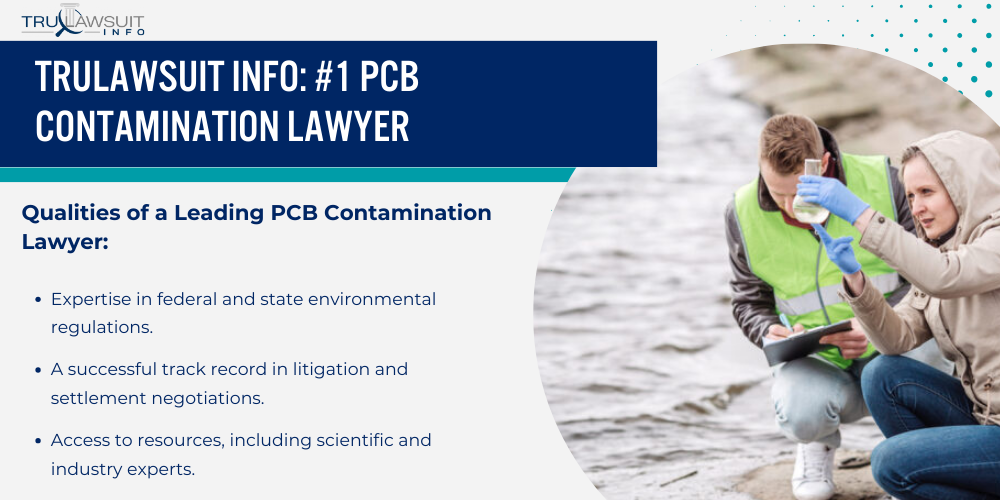
A top-tier PCB contamination lawyer typically offers comprehensive services geared toward achieving justice and compensation for affected individuals and communities.
Qualities of a Leading PCB Contamination Lawyer:
- Expertise in federal and state environmental regulations.
- A successful track record in litigation and settlement negotiations.
- Access to resources, including scientific and industry experts.
- A client-focused approach, providing personalized legal strategies.
Responsibilities of the Lawyer:
- Conducting thorough investigations into the sources of contamination.
- Filing suits against responsible parties, such as corporations or manufacturers.
- Advocating for the community’s right to a clean environment.
- Securing financial compensation for damages such as health issues and property devaluation.
Lawyers specializing in this area often collaborate with environmental agencies and may be at the forefront of high-profile class action lawsuits, such as the case against Monsanto for PCB contamination in Washington or the cleanup lawsuit for Wisconsin’s Fox River, discussed on the Attorney General’s page on the Monsanto settlement and the U.S. Department of Justice’s announcement.
To support community well-being, these attorneys often work on a contingency basis, as noted in the State of Vermont’s PCB case Q&A, ensuring that legal proceedings are accessible to those harmed by PCBs.
Choosing a lawyer with the right skills and dedication is significant in ensuring a steadfast response to the challenges presented by PCB contamination cases.
Frequently Asked Questions
-
PCBs have been linked to various health issues, including increased risk of cancer, immune system deficiencies, and reproductive disorders.
They can also cause skin conditions like chloracne and may lead to developmental problems in children.
-
Humans can be exposed to PCBs primarily through the consumption of contaminated food, especially contaminated fish that have accumulated PCBs in their fatty tissue.
Exposure can also occur by breathing air near contaminated sites or through skin contact with materials containing PCBs.
-
PCB contamination commonly originates from industrial spills, improper disposal of PCB-containing equipment, and leakage from landfills.
Historical use of PCBs in various applications has also contributed to widespread environmental contamination.
-
Due to their insulating properties, PCBs have historically been used extensively in the electrical industry.
They were also found in hydraulic systems, heat transfer fluids, and other products like paints, sealants, and plastics.
-
Symptoms of PCB poisoning can vary but often include skin rashes and pigmentation changes, mucus discharge from the eyes and nose, fatigue, headaches, coughing, and gastrointestinal discomfort.
-
PCBs are most likely to be found in environments with a history of industrial use, such as near electrical manufacturing sites, in sediment and water of polluted waterways, and in soils of areas where PCB waste was disposed.

Attorney Jessie Paluch, founder of TruLawsuit Info, has over 25 years of experience as a personal injury and mass tort attorney, and previously worked as an international tax attorney at Deloitte. Jessie collaborates with attorneys nationwide — enabling her to share reliable, up-to-date legal information with our readers.
Legally Reviewed
This article has been written and reviewed for legal accuracy and clarity by the team of writers and legal experts at TruLawsuit Info and is as accurate as possible. This content should not be taken as legal advice from an attorney. If you would like to learn more about our owner and experienced injury lawyer, Jessie Paluch, you can do so here.
Fact-Checked
TruLawsuit Info does everything possible to make sure the information in this article is up to date and accurate. If you need specific legal advice about your case, contact our team by using the chat on the bottom of this page. This article should not be taken as advice from an attorney.
You can learn more about the PCB Exposure Lawsuit by visiting any of our pages listed below:
Here, at Tru Lawsuit Info, we’re committed to helping victims get the justice they deserve.
To do this, we actively work to connect them with attorneys who are experts in litigating cases similar to theirs.
Table of Contents
Tru Lawsuit Info is a reliable source of information about issues that may affect your health and safety, such as faulty products, data breaches, and environmental hazards.
Our team of experienced writers collaborates with medical professionals, lawyers, and advocates to produce informative articles, guides, and other resources that raise awareness of these topics.
Our thorough research provides consumers with access to reliable information and updates on lawsuits happening around the country. We also can connect consumers with attorneys if they need assistance.
Here, at Tru Lawsuit Info, we’re committed to helping victims get the justice they deserve.
To do this, we actively work to connect them with attorneys who are experts in litigating cases similar to theirs.
